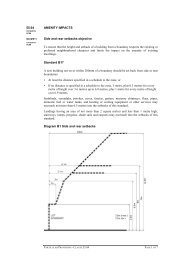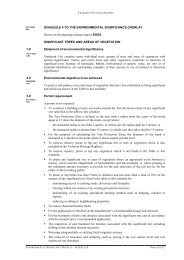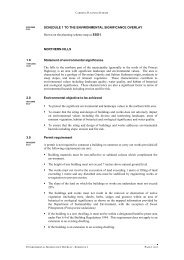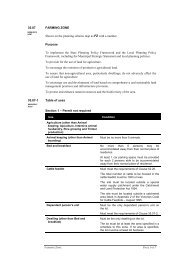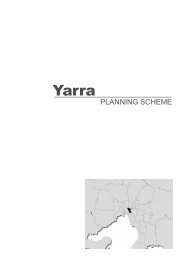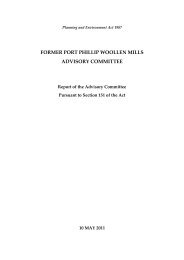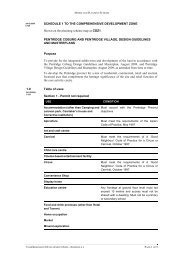OT chimney citation FINAL 180411 - Victoria's Planning Schemes
OT chimney citation FINAL 180411 - Victoria's Planning Schemes
OT chimney citation FINAL 180411 - Victoria's Planning Schemes
Create successful ePaper yourself
Turn your PDF publications into a flip-book with our unique Google optimized e-Paper software.
NAME OF PLACE: <strong>OT</strong> <strong>chimney</strong>.<br />
<strong>OT</strong> CHIMNEY<br />
PART HO126<br />
<strong>OT</strong>HER NAMES OF PLACE: Former Kia-ora Cordial factory <strong>chimney</strong>, former Red Tulip factory<br />
<strong>chimney</strong>.<br />
ADDRESS / LOCATION: Part 181-187 High Street, Prahran, VIC 3181.<br />
PROPERTY INFORMATION: Not available.<br />
EXISTING LISTINGS: The buildings at 12 Anchor Place were graded C as part of Prahran<br />
Conservation Study 1 and are currently protected under HO126, the<br />
Chapel Street Area. Beyond this, no part of the Red Tulip site has<br />
been assessed by previous heritage studies or is currently subject<br />
to a heritage control.<br />
LEVEL OF SIGNFICANCE: This document recommends an A2 grading for the <strong>OT</strong> <strong>chimney</strong>. It<br />
also recommends that the boundary to HO126 be adjusted locally to<br />
include the <strong>OT</strong> <strong>chimney</strong>.<br />
ASSESSED BY: John Statham, Heritage Advisor, City of Stonnington.<br />
ASSESSMENT DATE: March 2011.<br />
STATEMENT OF SIGNIFICANCE<br />
What is significant?<br />
The former Kia-ora/Red Tulip factory complex is notable as one of a small number of large early industrial<br />
sites within the Windsor/South Yarra area. The original cordial manufacture and later chocolate production<br />
uses of the site were largely overwritten as part of the conversion of the factory to apartments through the<br />
1990s. Nonetheless, the early industrial use of the site remains legible through some remnant facades and<br />
by the presence an early <strong>chimney</strong> to Hillingdon Place. This is one of only two, large industrial <strong>chimney</strong>s to<br />
survive within the Municipality.<br />
How is it significant?<br />
The <strong>OT</strong> <strong>chimney</strong> is of local social, historical and aesthetic significance.<br />
What is significant?<br />
The former Kia-ora/Red Tulip factory is significant as a reminder of the former industrial character of the<br />
South Yarra and Windsor and specifically of the food processing enterprises which operated on the site from<br />
the c.1910 until the 1980s. The site is of historical significance as the headquarters of the Kia-ora Cordials<br />
and Red Tulip Chocolates, major names in the history of the Victorian and international food industries. The<br />
site generally, and the <strong>chimney</strong> in particular, is of social significance as an illustration of an early phase of<br />
local manufacturing, most specifically the sub theme, 6.2.2 ‘Food Processing’, identified in Council’s<br />
Thematic Environmental History. The <strong>chimney</strong> is significant as a local landmark visible from a range of local<br />
vantagepoints.<br />
1 Nigel Lewis and Associates, Prahran Conservation Study, 1992, pg. DC-32.<br />
Part<br />
HO126
DESCRIPTION<br />
The former Red Tulip factory occupied much of the site bounded by Anchor Place, Clifton Street, High Street<br />
and Hillingdon Place. At the time of its closure in the 1980s, the site contained a group of handsome, red<br />
brick buildings to Anchor and Hillingdon Places, some generic sheds and production areas and outdoor<br />
forwarding and receiving bays. A boiler room and ornate <strong>chimney</strong> to the Hillingdon Place frontage provided<br />
steam to the factory. The <strong>chimney</strong> survives in good condition. It was constructed in red face brick adopting a<br />
circular cross-section tapering to a rendered cap. Decorative brackets to the underside of the cap are also of<br />
face brick. MMBW plans suggest that the <strong>chimney</strong> was constructed c.1910s. Chocolate manufacturers, Red<br />
Tulip, occupied the site from 1965. However, painted ‘<strong>OT</strong>’ branding to the <strong>chimney</strong> - referring to a cordial<br />
manufactured on the site through the early part of the twentieth century - survives.<br />
PH<strong>OT</strong>OS<br />
Figure 1 <strong>OT</strong> Chimney (viewed from Hillingdon Place).<br />
Figure 2 Hillingdon Place and the <strong>OT</strong> Chimney (viewed from north).<br />
HISTORY<br />
The Kia-ora company was founded by John Dixon. 2 It was originally established at 83 Alfred Street as the<br />
Prahran Ice and Aerated Water Co, becoming the Kia-ora Company around 1905. Kia-ora was the<br />
company’s brand name for lemonade. ‘<strong>OT</strong>’ was the name of a hot punch used to spice up beer in winter or in<br />
soft drinks. The factory was relocated to Hillingdon Place c.1910. 3 The site was developed heavily through<br />
the 1910s and 1920s becoming an extensive industrial complex by 1930 (Refer Figure 3).<br />
As early as 1911 the company had agents in England, India, South Africa, Singapore, Hong Kong, Japan,<br />
Korea and Fiji. Factories were subsequently constructed in Great Britain (1917), San Francisco in the US,<br />
Valencia in Spain and Messina in Italy but the headquarters remained on High Street, Prahran.<br />
2 Sally Wilde, History of Prahran Volume II: 1925-1990, pg. 153.<br />
3 Melbourne Metropolitan Board of Works, Plan of drainage 80507, 1911, describes the earliest drainage works on the site.
In 1929 the business was sold to a public company and the whole concern operated under the name of Kiaora<br />
Industries Ltd. After World War II the company diversified into canned food, including baked beans,<br />
spaghetti and soup, but Kia-ora orange drink remained the brand leader in Australia and the United<br />
Kingdom. Throughout this expansion, the origins of the company were not forgotten and the '<strong>OT</strong>' branding<br />
remained in large letters on the <strong>chimney</strong> above the Prahran factory.<br />
Figure 3 Melbourne Metropolitan Board of Works, <strong>OT</strong> Cordial Works, from Plan of drainage 42538, c.1930.<br />
Figure 4 <strong>OT</strong> Chimney (viewed from the north).<br />
In 1965, Red Tulip Chocolates Pty Ltd took over the site. This enterprise also enjoyed some local and<br />
international success before a new factory was opened on a more spacious site in Scoresby in 1976. In 1988<br />
Red Tulip was taken over by Cadbury-Schweppes and the Prahran factory was closed. The factory was<br />
subsequently redeveloped as apartments. Nonetheless, the <strong>chimney</strong> survives in good condition and remains<br />
a local landmark.<br />
ANALYSIS<br />
Previous Heritage Studies<br />
The buildings at 12 Anchor Place were graded C as part of Prahran Conservation Study, 1992. They are<br />
currently protected as part of the Chapel Street Heritage Overlay area (HO126). No other part of the former<br />
Red Tulip factory is currently protected under a heritage control.<br />
Thematic context<br />
The <strong>chimney</strong> illustrates Theme 6.2.2, Food Processing, as identified in the City of Stonnington Thematic<br />
Environmental History, and industrial development more generally. The Kia Ora and Red Tulip brands are<br />
specifically noted in Council’s Thematic Environmental History.
Comparative analysis<br />
Manufacturing in Prahran<br />
In her, History of Prahran Volume II: 1925-1990, Sally Wilde notes 4 , that ‘during the 20th century, Prahran's<br />
best known manufacturing industries have perhaps been the brickworks at the northern end of Chapel<br />
Street, Hecla and Electrolux which took over some of the land formerly devoted to brickmaking, Henry Jones<br />
IXL's jam factory further south on Chapel Street, <strong>OT</strong> Cordials (later known as Kia-ora) and Red Tulip<br />
chocolates … At their peak, between them Prahran's manufacturers employed thousands of people, but<br />
medium-scale electrical goods production and food processing were not really typical of manufacturing<br />
industry in Prahran. Generally this was small-scale with a wide range of enterprises, each employing a<br />
couple of dozen people or less. Perhaps half of the factories in Prahran at any one time were involved in<br />
some branch of the clothing and textile industry - dressmaking, tailoring, men's ties, underwear … furniture<br />
making was also important, especially in the inter-war years. There were also a number of large timber<br />
yards, including Linay's on the corner of Chapel and Gray Streets, Smith's in River Street and Davis's on the<br />
corner of Williams and Malvern Roads’.<br />
Figure 5 Part HO126, from www. dse.vic.gov.au/planningschemes/stonnington/maps/stonnington04ho.pdf<br />
Figure 6 Proposed extent of HO126, from KA Reed Co Pty Ltd, Plan of Subdivision, PS410665J, 9/7/1997. Original held on file,<br />
Building Department, City of Stonnington.<br />
With the exception of the former Jam Factory, the former Kia-ora/Red Tulip factory and a handful of small<br />
workshops such as those that survive above the retail outlets in Chapel Street, all of the sites noted by Wilde<br />
have been lost to redevelopment.<br />
4 Sally Wilde, History of Prahran Volume II: 1925-1990, pg.145-6.
Other Cordial manufacturers<br />
Although Kia-ora has had the longest association with the area, it is not the only cordial manufacturer to<br />
have operated in Prahran. Gouldings Aerated Water had operated from a site on High Street, to the west of<br />
Chapel Street, through the late nineteenth and early twentieth centuries. 5 Cottee's Passiona, a New South<br />
Wales company, began its Victorian operation on Cliff Street, Prahran, in 1939 6 . It also operated a factory on<br />
Chapel Street before moving to more spacious premises in Blackburn in 1951. A great deal of fruit was<br />
processed in Prahran, but most was either canned or bottled as jam rather than turned into cordial.<br />
Other industrial <strong>chimney</strong>s<br />
The former Jam Factory and Kia-ora sites are the only instances within the City of Stonnington where food<br />
production on a large scale remains evident. These sites also retain the only two extant industrial <strong>chimney</strong>s<br />
in the Municipality. In the former City of Malvern, <strong>chimney</strong>s associated with brickmaking in Toorak and<br />
Tooronga and at north end of Chapel Street have been lost. Chimneys at Cawkwell’s tile works have likewise<br />
been demolished. Closer to the subject site, the former City of Prahran Municipal incinerator and other<br />
stacks visible in early photographs of South Yarra have been demolished. Of the two surviving <strong>chimney</strong>s, the<br />
<strong>OT</strong> <strong>chimney</strong> appears more decorative and to survive in better condition than that surviving at the Jam<br />
Factory.<br />
RECOMMENDATIONS<br />
HO126 currently extends over the two most northerly building volumes of the former factory complex. The<br />
extent of the boundary to HO126 in the vicinity of the former Red Tulip Factory should be refined to include<br />
those areas identified in Figure 6. This would incorporate the <strong>OT</strong> <strong>chimney</strong> into HO126 and better define the<br />
extent of the heritage control as it applies to built form along Anchor Place.<br />
On the basis of the research undertaken in the preparation of this report, an A2 grading is recommended for<br />
the <strong>OT</strong> <strong>chimney</strong>.<br />
REFERENCES<br />
Context Pty Ltd, Stonnington Thematic Environmental History, 2006.<br />
Nigel Lewis and Associates, Prahran Conservation Study, Identification of Buildings and Areas of Major<br />
Significance, 1992.<br />
Sally Wilde, History of Prahran Volume II: 1925-1990, 1993.<br />
Melbourne and Metropolitan Board of Works, Detail Plan 960, 1896.<br />
Melbourne and Metropolitan Board of Works, Detail Plan 960, c.1920.<br />
Victorian <strong>Planning</strong> <strong>Schemes</strong> Online,<br />
www. dse.vic.gov.au/planningschemes/stonnington/maps/stonnington04ho.pdf.<br />
5 City of Stonnington History Centre, Gouldings Aerated Waters, Registration No PH7277.<br />
6 Sally Wilde, History of Prahran Volume II: 1925-1990, pg.154.



